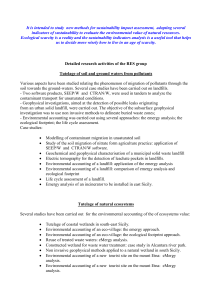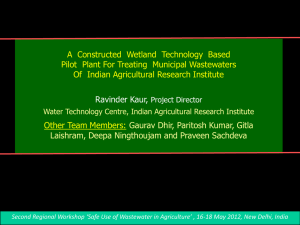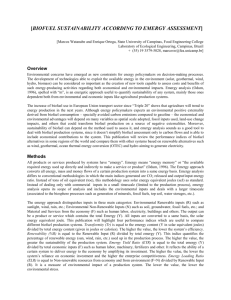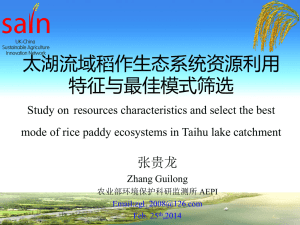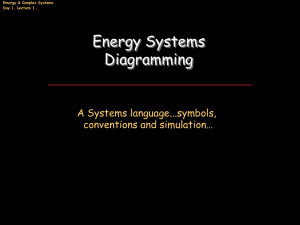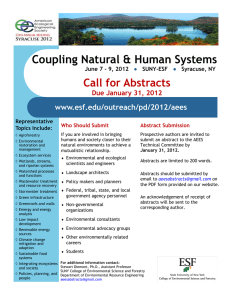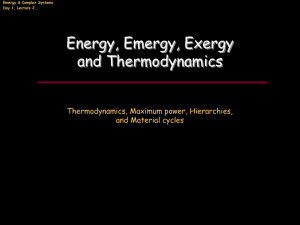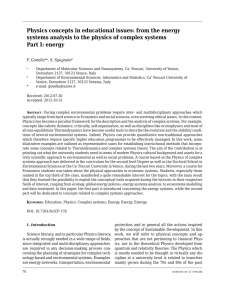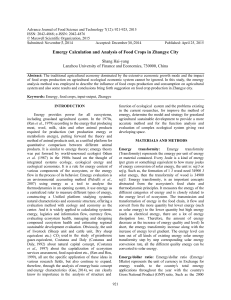S
advertisement
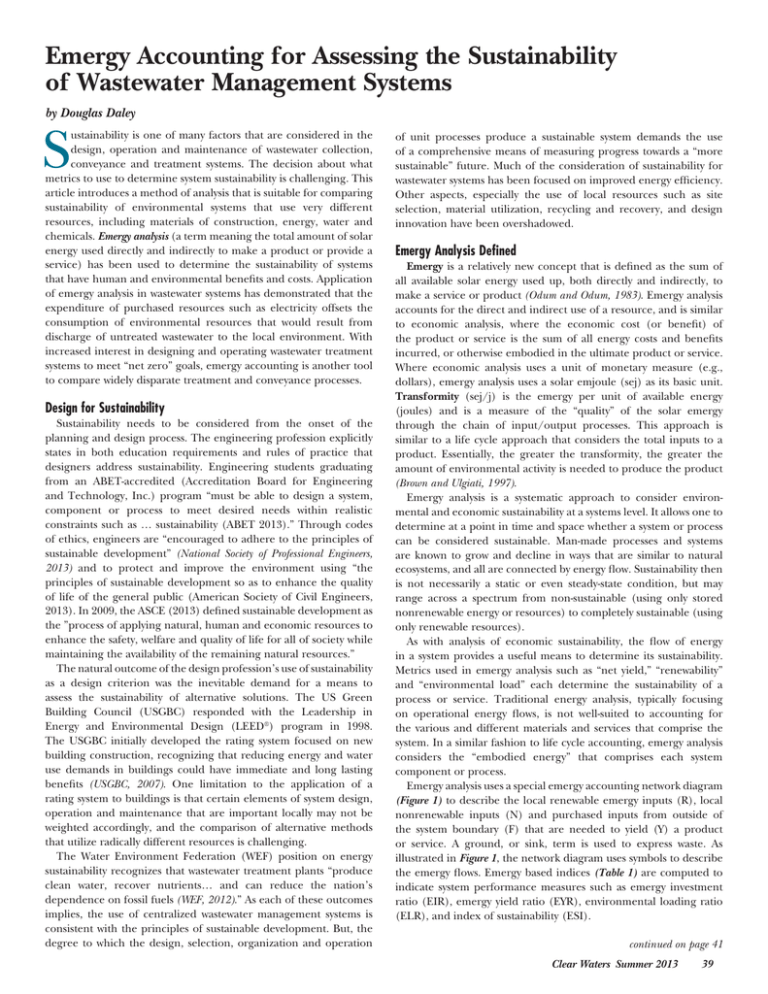
Emergy Accounting for Assessing the Sustainability of Wastewater Management Systems by Douglas Daley S ustainability is one of many factors that are considered in the design, operation and maintenance of wastewater collection, conveyance and treatment systems. The decision about what metrics to use to determine system sustainability is challenging. This article introduces a method of analysis that is suitable for comparing sustainability of environmental systems that use very different resources, including materials of construction, energy, water and chemicals. Emergy analysis (a term meaning the total amount of solar energy used directly and indirectly to make a product or provide a service) has been used to determine the sustainability of systems that have human and environmental benefits and costs. Application of emergy analysis in wastewater systems has demonstrated that the expenditure of purchased resources such as electricity offsets the consumption of environmental resources that would result from discharge of untreated wastewater to the local environment. With increased interest in designing and operating wastewater treatment systems to meet “net zero” goals, emergy accounting is another tool to compare widely disparate treatment and conveyance processes. Design for Sustainability Sustainability needs to be considered from the onset of the planning and design process. The engineering profession explicitly states in both education requirements and rules of practice that designers address sustainability. Engineering students graduating from an ABET-accredited (Accreditation Board for Engineering and Technology, Inc.) program “must be able to design a system, component or process to meet desired needs within realistic constraints such as … sustainability (ABET 2013).” Through codes of ethics, engineers are “encouraged to adhere to the principles of sustainable development” (National Society of Professional Engineers, 2013) and to protect and improve the environment using “the principles of sustainable development so as to enhance the quality of life of the general public (American Society of Civil Engineers, 2013). In 2009, the ASCE (2013) defined sustainable development as the ”process of applying natural, human and economic resources to enhance the safety, welfare and quality of life for all of society while maintaining the availability of the remaining natural resources.” The natural outcome of the design profession’s use of sustainability as a design criterion was the inevitable demand for a means to assess the sustainability of alternative solutions. The US Green Building Council (USGBC) responded with the Leadership in Energy and Environmental Design (LEED®) program in 1998. The USGBC initially developed the rating system focused on new building construction, recognizing that reducing energy and water use demands in buildings could have immediate and long lasting benefits (USGBC, 2007). One limitation to the application of a rating system to buildings is that certain elements of system design, operation and maintenance that are important locally may not be weighted accordingly, and the comparison of alternative methods that utilize radically different resources is challenging. The Water Environment Federation (WEF) position on energy sustainability recognizes that wastewater treatment plants “produce clean water, recover nutrients… and can reduce the nation’s dependence on fossil fuels (WEF, 2012).” As each of these outcomes implies, the use of centralized wastewater management systems is consistent with the principles of sustainable development. But, the degree to which the design, selection, organization and operation of unit processes produce a sustainable system demands the use of a comprehensive means of measuring progress towards a “more sustainable” future. Much of the consideration of sustainability for wastewater systems has been focused on improved energy efficiency. Other aspects, especially the use of local resources such as site selection, material utilization, recycling and recovery, and design innovation have been overshadowed. Emergy Analysis Defined Emergy is a relatively new concept that is defined as the sum of all available solar energy used up, both directly and indirectly, to make a service or product (Odum and Odum, 1983). Emergy analysis accounts for the direct and indirect use of a resource, and is similar to economic analysis, where the economic cost (or benefit) of the product or service is the sum of all energy costs and benefits incurred, or otherwise embodied in the ultimate product or service. Where economic analysis uses a unit of monetary measure (e.g., dollars), emergy analysis uses a solar emjoule (sej) as its basic unit. Transformity (sej/j) is the emergy per unit of available energy (joules) and is a measure of the “quality” of the solar emergy through the chain of input/output processes. This approach is similar to a life cycle approach that considers the total inputs to a product. Essentially, the greater the transformity, the greater the amount of environmental activity is needed to produce the product (Brown and Ulgiati, 1997). Emergy analysis is a systematic approach to consider environmental and economic sustainability at a systems level. It allows one to determine at a point in time and space whether a system or process can be considered sustainable. Man-made processes and systems are known to grow and decline in ways that are similar to natural ecosystems, and all are connected by energy flow. Sustainability then is not necessarily a static or even steady-state condition, but may range across a spectrum from non-sustainable (using only stored nonrenewable energy or resources) to completely sustainable (using only renewable resources). As with analysis of economic sustainability, the flow of energy in a system provides a useful means to determine its sustainability. Metrics used in emergy analysis such as “net yield,” “renewability” and “environmental load” each determine the sustainability of a process or service. Traditional energy analysis, typically focusing on operational energy flows, is not well-suited to accounting for the various and different materials and services that comprise the system. In a similar fashion to life cycle accounting, emergy analysis considers the “embodied energy” that comprises each system component or process. Emergy analysis uses a special emergy accounting network diagram (Figure 1) to describe the local renewable emergy inputs (R), local nonrenewable inputs (N) and purchased inputs from outside of the system boundary (F) that are needed to yield (Y) a product or service. A ground, or sink, term is used to express waste. As illustrated in Figure 1, the network diagram uses symbols to describe the emergy flows. Emergy based indices (Table 1) are computed to indicate system performance measures such as emergy investment ratio (EIR), emergy yield ratio (EYR), environmental loading ratio (ELR), and index of sustainability (ESI). continued on page 41 Clear Waters Summer 2013 39 Brown and Ulgiati, 1997 continued from page 39 Figure 1. Emergy Accounting Network Flow Diagram As expected, if one strives to achieve sustainability, a system should be designed and operated to maximize the emergy yield ratio EYR (by reducing purchased emergy, or increasing emergy yield) and/ or to minimize the ELR (by increasing the use of renewable emergy resources or decreasing the use of purchased and nonrenewable emergy resources). High values of EYR (EYR>5) would have high economic benefit, as well as favorable competition against other resources. Low values of ELR (ELR<2) indicate either low environmental impact, or processes that have a large area in which to minimize the environmental impacts (e.g., large assimilation capacity). Finally, processes and systems with an ESI >5 are considered sustainable in the long-term, while 1<ESI<5 may have sustainable aspects over shorter periods. An ESI<1 is not considered sustainable in the long term; conversely, an ESI>10 may indicate that the system is underdeveloped and does not meet the sustainability definition of providing economic and environmental benefits. Ecological engineering activities in the water environment, such as treatment wetlands and green infrastructure, emphasize the effective use of both renewable and nonrenewable emergy such that there is not only a net benefit to society, but environmental load is minimized. Brown and Ulgiati (1997) point out that the ESI is a Table 1. Emergy-Based Indices Emergy Based Index Emergy Investment Ratio (EIR) Formula = F/(N+R) Emergy Yield Ratio (EYR) = Y/F Environmental Loading Ratio (ELR) = (F+N)/R Emergy Sustainability Index (ESI) = EYR/ELR function of three variables, not just two as the ratio might indicate. Thus, sustainability is not just predicated by a low requirement of feedbacks; a large input of emergy from outside the system may be sustainable as long as this creates an opportunity to exploit a very large amount of emergy from local renewable resources. What distinguishes the emergy analysis from other types of sustainability assessments is findings such that wastewater inputs to a typical wastewater treatment facility represent the greatest emergy input due to wastewater’s material, thermal, chemical and potential energy content. Oxygen consumption is the greatest renewable emergy contribution while construction materials and electricity dominate non-renewable external resources. Emergy analyses have found that the large amount of emergy in wastewater is balanced by the amount of resources used for treatment and the extensive ecosystem effects that would result from the discharge of untreated wastewater (Bjorklund, Geber and Rydberg, 2001). Case Studies Emergy evaluations are used to determine environmental sustainability for systems that produce environmental and human benefits. Emergy analysis was able to quantify the increased environmental sustainability achieved at a municipal wastewater treatment plant when a reclaimed water reuse subsystem and aerobic sludge compost subsystem replaced potable water use and landfilling (Zhang, Deng, Wu and Jiang, 2010). The advantage of using the emergy evaluation was that they were able to incorporate the emergy value of human health impacts from air pollutant emissions and the emergy value of the landfill resource into the analysis. Three waste management systems (composting, landfilling and waste-to-energy) were evaluated using emergy analysis (Marchettini, Ridolfi and Rustici, 2007). This study determined that composting (EYR=3.9) is better at recovering emergy (e.g., nutrients), but incineration is better at resource extraction, even if it is less efficient. As expected, landfill disposal (EYR=0.19) has a much greater resource use than either of the other two. Description Ratio of purchased resources and services (from outside the system) to the nonrenewable and renewable emergy inputs inside the system boundary Ratio of emergy yield of output to emergy inputs from outside the system. Measure of the ability of the process to exploit local, rather than outside, resources Ratio of purchased and nonrenewable emergy to the renewable emergy. A measure of ecosystem stress due to the production activity. Brown and Ulgiati,1997. Table 2. Examples of transformity values used in emergy analysis of wastewater systems. Transformity is the amount of solar energy needed to produce one unit of resource. Typical Examples for Wastewater Emergy Resource Treatment Processes (units: J=joule, g=gram) Renewable Emergy Inflow (R) Sun (J) Wind (J) Rain (chemical potential) (J) Oxygen (g) Nonrenewable Emergy Inflow (N) Wastewater (J) Purchased Emergy Inflow (F) Treatment chemicals (g) Human labor (J) Electricity (J) Water (g) Concrete (g) Copper (g) Brown and Ulgiati,1997; Bjorklund, Geber and Rydberg, 2001. Transformity (sej/unit) 1 1.47E+03 1.79E+04 5.06E+07 3.73E+06 3.73E+08 7.24E+06 1.71E+05 7.16E+06 7.34E+08 6.80E+10 continued on page 43 Clear Waters Summer 2013 41 Vassallo, Paoli and Fabiano, 2009 continued from page 41 Figure 2. Schematic diagram of emergy resources and flows in a wastewater treatment plant Emergy analysis was used to determine if the installation of a constructed treatment wetland at a small wastewater treatment plant would result in economic savings and environmental benefit. Water reuse, in particular, provides benefits to offset the use of high quality drinking water for process purposes. While water has high value associated with it as a natural capital, additional monetary and emergy value is added as it is conveyed, treated and stored. Emergy analysis was used to compare two very different wastewater treatment systems in a cold climate, including one conventional activated sludge process and a second including sand filtration followed by a constructed wetland. Due to its use of solar, wind and rain (chemical) energy, the treatment plant with constructed wetland used much more local (free) renewable energy (R) than the conventional WWTP. Interestingly, the treatment plant wetland treatment system also used a slightly greater amount of purchased resources (F) from society. While the emergy yield ratio (EYR =1.0) was equal for the two systems, the Environmental Load Ratio for the WWTP (ELR = 4246) was an order of magnitude greater than for the treatment plant with wetland (ELR=193). Both systems had a very low ESI (ESI <1), although the wetland system was an order of magnitude greater. Emergy Analysis for Sustainability Assessment Emergy analysis accounts for resource inputs to the wastewater treatment system using their energy content as the basis for evaluation. Published transformity values are used to determine the amount of energy needed from the accumulated resources that support that resource. Emergy accounting allows comparison of widely disparate technologies. Labor-intensive activities requiring human work can be incorporated into emergy analysis by considering a person’s metabolic energy use (i.e., the accumulated energy that it takes to support that person’s role in the system). Emergy accounting can be used to compute metrics that indicate a system’s resource use efficiency (yield ratio), its use of renewable or nonrenewable resources (emergy investment ratio), its environmental impact (environmental loading ratio), and its sustainability (emergy sustainability index). By accounting for all energy used, directly and indirectly in a system, these emergy-based indices provide designers, operators, managers and planners with a tool to assess the sustainability of complex systems in the water environment. Douglas Daley, PE, is Associate Professor of Environmental Resources Engineering at the State University of New York College of Environmental Science and Forestry in Syracuse, NY. He may be reached at djdaley@esf. edu. References ABET. (2013). Criteria for Accrediting Engineering Programs, 201212013. Retrieved February 7, 2013, from ABET Web Site: http:// www.abet.org/DisplayTemplates/DocsHandbook.aspx?id=3143 American Society of Civil Engineers. (2013, February 7). Code of Ethics. Retrieved February 7, 2013, from http://www.asce.org/ Leadership-and-Management/Ethics/Code-of-Ethics/ Bjorklund, J., Geber, U., & Rydberg, T. (2001). Emergy analysis of municipal wastewater treatment and generation of electricity by digestion of sewage sludge. Resources, Conservation and Recycling, 293-316. Brown, M., & Ulgiati, S. (1997). Emergy-based indices and ratios to evaluate sustainability: monitoring economies and technology toward environmentally sound innovation. J. Ecological Engineering, 51-69. Marchettini, N., Ridolfi, R., & Rustici, M. (2007). An environmental analysis for comparing waste management options and strategies. Waste Management, 562-571. National Society of Professional Engineers (NSPE). (2013). NSPE Code of Ethics for Engineers. Retrieved February 7, 2013, from NSPE Home: http://www.nspe.org/Ethics/CodeofEthics/index.html Odum, H., & Odum, E. (1983). Energy Analysis Overview of Nations. Laxenburg, Austria: International Institute for Applied Systems Analysis. US Green Building Council. (2007). New Construction & Major Renovation. Washington, D.C.: USGBC. Vassallo, P., Paoli, C., & Fabiano, M. (2009). Emergy required for the copmlete treatment of municipal wastewater. Ecological Engineering, 687-694. Water Environment Federation. (2012). Energy Roadmap Version 1.0 Driving Water and Wastewater Utilities to More Sustainable Energy Management. Washington, D.C.: Water Environment Federations. Zhang, X., Deng, S., Wu, J., & Jiang, W. (2010). A sustainability analysis of a municipal sewage treatment ecosystem based on emergy. Ecological Engineering, 685-696. Clear Waters Summer 2013 43
